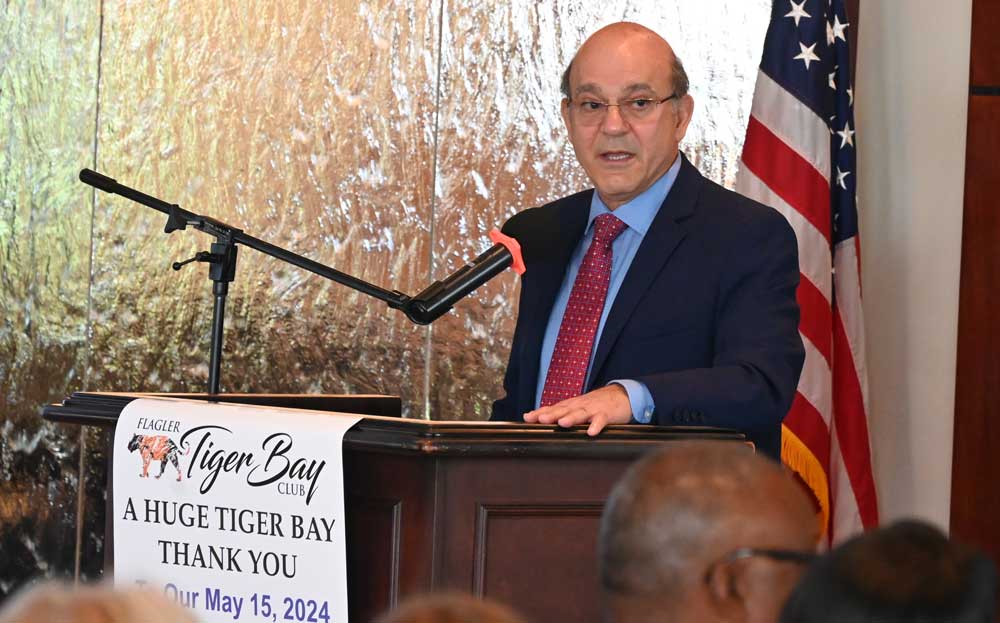
During the Q&A segment at the end of last week’s Flagler Tiger Bay lunch featuring County Attorney Al Hadeed, Flagler Beach City Commissioner Jane Mealy said she had a comment for the sold-out crowd, not a question: “Every government that was cooperating, every agency that was cooperating, all the volunteer groups, it’s all great,” she said, “but without that man’s grit and determination, this project would never have gotten off the ground.”
Mealy, who has held office almost long enough to remember that far back, was referring to the U.S. Army Corps of Engineers plan to rebuild miles of beach from North 7th Street in her city to the northern limit of Gamble Rogers State Recreation Area, a plan in the works (along a slightly shorter stretch) for over 20 years. The dredging operation that will dump over 1 million cubic yard of sand sucked up from the seafloor 11 miles offshore begins after Memorial Day. It was delayed three years as Hadeed worked to secure easements from owners of 140 properties along the length of the project area, all of whom eventually signed.
For all that round of applause, the Army Corps project was only one in a series of beach-related issues Hadeed spoke of in his half hour before the assembled. He had one aim: to impress on that collection of elected officials, residents and business representatives, some of them more influential than others locally, what role they must play if the efforts of the last eight years–since the repairs of Hurricane Matthew’s and Ian’s ravages against the coast–are to be sustained over the next 50 years, and certainly more.
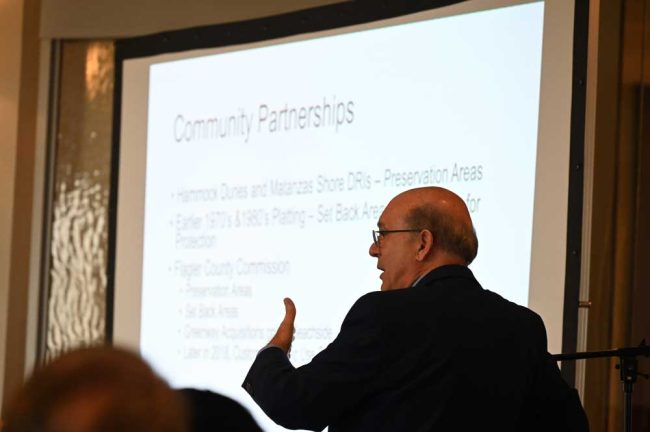
“It is so important that you take the determination that we have and educate people about what we’re facing and what we’re doing,” Hadeed said as he concluded. “We are going to have projects that are going to extend all the way up to Marineland. They’re going to occur in sequence. And we’re doing it in the best way we can. We have got to educate our citizenry about how important this is, our public officials about how important this is. Also, our partners in all the different agencies. They need to know how much we appreciate what they’ve done for us. That’s what I want you to take away. You’re the decision makers. It’s up to you to rally the troops so that we can complete these projects in a way that preserves our future.”
Hadeed acknowledged that there may be a sense of futility, “spinning our wheels, just throwing money at a problem, hoping it’ll go away?” He did not answer the question directly, or entirely. Not when there is always going to be some degree of futility: in 2018 the county launched an unprecedented $25 million dune reconstruction project along 11 of the county’s 18 miles of shoreline to rebuild what Hurricanes Matthew in 2016 and Hurricane Ian in 2017 had carved out. The dunes were rebuilt, under budget and ahead of time.
But by 2022, the dunes were gone as even nor’easters–not just named storms–and rising seas continued to erode the beaches. In early 2023 the county received another $14 million from the state and federal governments to repair beaches yet again. If that recent history is a guide, and as seas continue to rise, and as storm seasons seem to be intensifying–Kevin Guthrie, the state’s emergency management director, warned the Flagler Beach City Commission earlier this month that there could be 33 named storms this season, “the most ever”–that cycle may be the new norm.
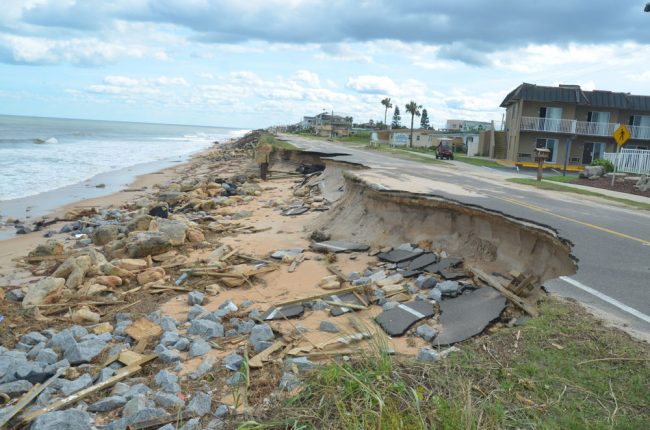
So Hadeed could answer his own question this way: “Well, know we had to do something.” But doing something doesn’t mean doing anything. He said sea walls don’t work, at least for the most part. “Those are not effective remedies. They are not,” he said. “Because if you rely on those kinds of structures, you will lose the character of your beach.” Sea walls over time enable the ocean to feed on and carry off the sanded beaches in front of them. Flagler Beach has some lengths of its beaches walled now, and a new wall is being built at the south end of the county’s beaches. Hadeed made exceptions for those. But the preferable method is the rebuilding of beaches and dunes. And for that, “grit and determination to get it done” is essential. Even if the ocean will wash it away.
He offered two examples: Jacksonville Beach, where the dunes have been rebuilt, and Marineland, where the Federal Emergency Management Administration rebuilt that shoreline after Hurricane Floyd in 1999. Some of the shoreline again eroded, and has again been renourished. But Marineland remains.
Meanwhile Flagler County over the years seemed “kind of immune from hurricanes,” since it had never taken a direct hit. That lulled the county into thinking it had nothing to worry about. It never developed a beach-management plan. Hurricane Matthew’s destruction, even though it never made landfall–all its damages were caused by mere tropical storm force winds and waves–shook the county awake. “The images were poignant, they spoke of incredible destruction,” Hadeed said, showing some of the jagged remains of State Road A1A after Matthew. The county got to work, drawing down state and federal dollars to rebuild what it could not afford to do on its own.
“If you don’t have any money, what can you throw into the equation that makes it work? Grit and determination. You’re going to get this done, you’re going to surmount whatever is necessary to get it done,” he said.
No matter what the ocean does.
If Hadeed had had time–Tiger Bay is strict with time allotments–he could have invited his audience to step outside and walk the hundred yards to the edge of a croquet court adjoining the dining room to show them how Hurricane Ian in December 2022 had obliterated the dunes and created a Cliffs-of-Dover-like wall right up to the court, wiping out the county’s dune-rebuilding efforts of 2019, and how the county yet again rebuilt the dunes there to their present, precarious form, with wisps of vegetation attempting to have what is bound to be another short life span. Here’s what it looked like after Ian:
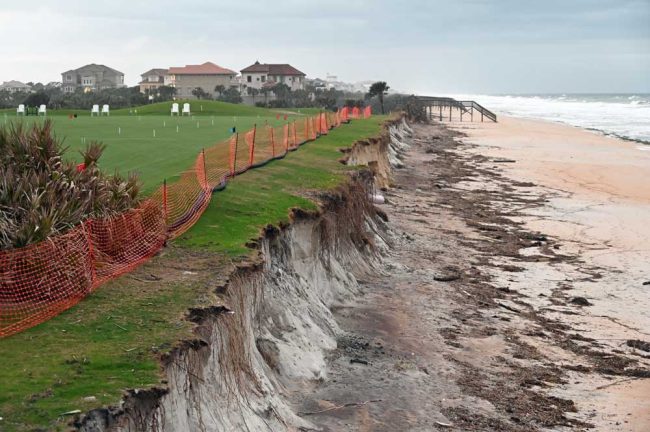
Here’s what it looked like last Wednesday, though you can see, from the gaping voids beneath the walkovers–which were intended to bridge dunes, but now bridge nothing–that county efforts could only rebuild a very small portion of the lost dune structure and beach:
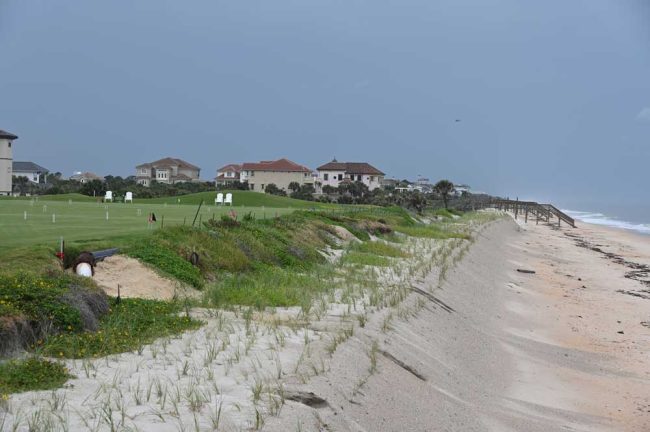
The Army Corps project in Flagler Beach will do a much more massive job of rebuilding dunes and beach: the beach itself will widen, the dunes will rise higher and expand more broadly. The federal limits of the project are actually between South 6th and South 28th Street. But the county’s “grit and determination” secured money to broaden that limit to North 7th Street and further south.
A few years ago, as numerous land owners were holding out against signing easements, the Army Corps was getting impatient and threatening the county to pull the $17.5 million in federal funding from the project and spend it elsewhere. Carla Cline and Craig Atack, two Flagler Beach residents, launched a fund-raiser and quickly collected upwards of $60,000 to be used as incentive money with those hold-outs. It worked with most of them, leaving only a handful, then eventually just one, who drew out the dance for over a year. Hadeed drafted Flagler Beach attorney Scott Spradley to help resolve that one. It was.
Spradley wasn’t in the audience at last week’s Tiger Bay lunch, but Cline was, and got her round of applause. “This is a marker of our grit and determination,” Hadeed said.
![]()





























Roger Cullinane says
We are very fortunate to have Al Hadeed putting so much effort into getting our beach and dunes rebuilt. This is one of the most important issues facing our community and will impact all of us forever.
Joe D says
Bravo Commissioner Mealy! And congratulations to attorney Al Hadeed. This is what can be accomplished when public servants ACTUALLY SERVE the PUBLIC.
This is ANOTHER reason why TERM limits at the local level don’t work for SMALL communities. At SOME point, small communities will run out of QUALIFIED/DEDICATED candidates if a term limit law is enforced at a local level.
This process of beach protection /replenishment/preservation and improvement has been a long (and unfortunately) done in MULTIPLE attempts as we try to preserve our coast ( and YES, at great expense).
I personally applaud Mr. Hadeed, the Flagler Beach Commission and City Staff for their LOVE (YES “love”), of Flagler Beach preservation over a LONG process.
James says
Such is the stuff…
“The stuff that dreams are made of.”
Just an observation.
endangered species says
erosion has been banned by racist ron so problem solved. We shouldnt speak of hurricanes, tornadoes, water temps, pfas, pollution, erosion, habitat loss, biodiversity loss, algae blooms, ect they will all magically go away if we dont mention them. Corrupt leadership at its finest.
Michael J Cocchiola says
Fortunately, Flagler County and its coastline are forever wedded… bolted at the hip. We’re just another pleasant but not noteworthy Florida community without our beaches. If we give up on the beaches, we give up our identity and a reason for people to visit or move here.
So, we must accept that we will fight the relentless Atlantic Ocean for our beautiful beaches. We’ll have to make the best economic decisions with the technology we have until something better evolves.
It is the burden we chose when we moved here.
Pogo says
@Lots of talk of the future
…but not all the present:
“…It’s called the Doomsday Glacier because of its potential to dramatically raise sea levels in places such as Florida…”
https://www.msn.com/en-us/weather/topstories/the-doomsday-glacier-in-antarctica-is-melting-faster-than-scientists-thought/ar-BB1mJt2d?OCID=ansmsnnews11